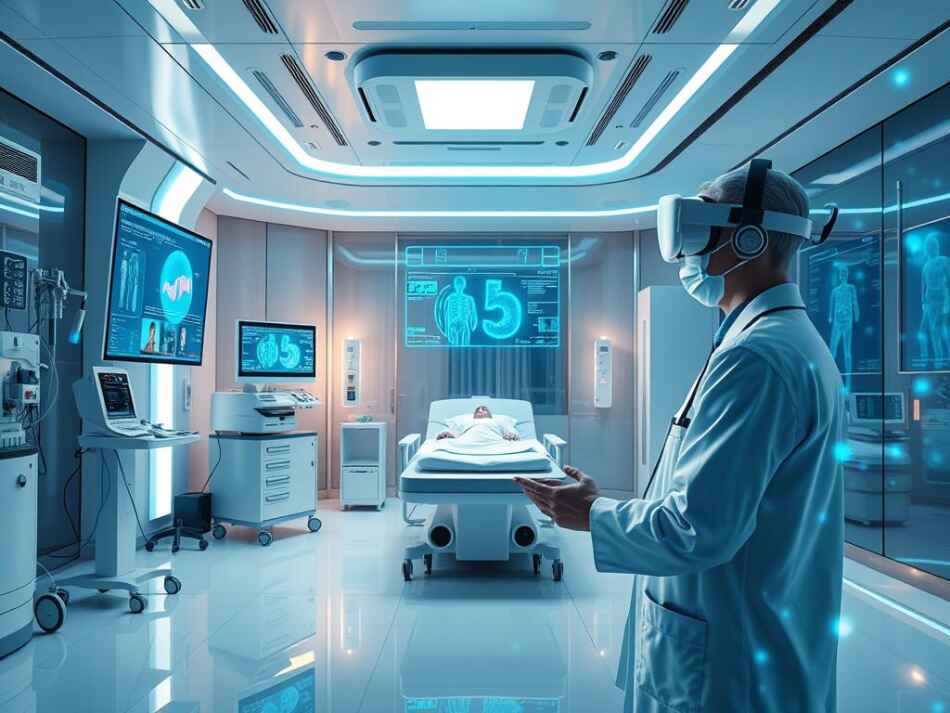I remember the day I first tried 5G technology. It felt like entering a new world where everything moved fast. Watching a live sports event on my phone without lag was amazing.
This experience showed me 5G’s huge potential. It can change how we live and work.
5G is more than just fast internet on phones. It’s a big change for how we interact. With speeds up to 100 times faster than 4G, 5G makes real-time communication possible.
Imagine doctors doing surgeries from far away. Cars talking to each other to avoid accidents. Smart cities using resources wisely in real-time. This isn’t fantasy – 5G is making it real.
5G is changing many industries. From healthcare to manufacturing, it’s making a big difference. Its low latency, almost 1 millisecond, makes things possible that were once dreams.
We’ll see how 5G applications are bringing new ideas and efficiency to different areas. Let’s dive into this exciting topic.
Understanding 5G Network Fundamentals
5G technology is changing our digital world. It brings new features and ways to connect. Moving from 4G to 5G means faster speeds, better reliability, and more connectivity.
Ultra-Fast Network Speeds and Capabilities
5G has speeds up to 10 Gbps. That’s much faster than 4G. It makes streaming, downloading, and talking in real-time smooth.
The network is now almost instant, with just 1 millisecond of delay. This makes everything feel quicker.
Network Infrastructure and Coverage
5G uses new cell towers and small cells for wide coverage. It aims for 99.999% availability and 100% coverage. This network can handle up to 1 million devices per square kilometer.
This is great for busy cities and smart cities.
Evolution from 4G to 5G Technology
The move from 4G to 5G is huge. 5G has 1000 times more bandwidth than 4G LTE. It supports more devices, uses less energy, and opens up new uses like self-driving cars and remote surgery.
By 2029, 5G will be in over 60% of mobile subscriptions worldwide.
| Feature | 4G | 5G |
|---|---|---|
| Peak Data Rate | 100 Mbps | 10 Gbps |
| Latency | 20-30 ms | 1 ms |
| Device Density | 100,000/km² | 1,000,000/km² |
Low Latency 5G Applications
I’m excited to explore the groundbreaking world of low latency 5G applications. These real-time applications are changing industries in big ways. The fast response of 5G networks makes new things possible.
In manufacturing, 5G is making smart factories a reality. Robots can now talk and work together fast. This makes production lines more efficient and precise.
Healthcare is also getting a boost from 5G. Now, surgeons can operate on patients from far away. Systems can watch patients closely and act fast if needed.
The transportation world is changing too. 5G helps cars and roads talk to each other fast. This makes driving safer and traffic flow better in smart cities.
| 5G Use Case | Latency Requirement | Impact |
|---|---|---|
| Remote Surgery | < 1 ms | Enables real-time surgical procedures from a distance |
| Autonomous Vehicles | < 5 ms | Facilitates instant decision-making for road safety |
| Industrial Automation | < 10 ms | Supports real-time control of robotic systems |
As we look into 5G, it’s clear low latency is key. It’s changing healthcare, manufacturing, and more. Real-time applications are starting to change our world in amazing ways.
Revolutionary Impact on Healthcare and Telemedicine
5G technology is changing healthcare with its fast speeds and low delay. It opens new ways for telemedicine and tracking patients from afar.
Remote Surgery and Real-time Diagnostics
Remote surgery is now possible with 5G. Its delay is less than 1 millisecond, making distant surgeries precise. High-resolution medical images can be sent instantly, speeding up diagnosis.

Patient Monitoring Systems
5G makes tracking patients better by supporting many devices at once. It lets doctors keep an eye on patients’ health and alert them quickly. This means patients get help fast, even if they’re far away.
Telehealth Communication Platforms
Telehealth platforms work great with 5G’s fast connections. Video calls are clear, and big files move quickly. This makes online doctor visits just as good as in-person ones, helping more people get care.
| Feature | 4G LTE | 5G | Impact on Healthcare |
|---|---|---|---|
| Data Speed | 50-300 Mbps | Up to 10 Gbps | Faster transmission of medical data |
| Latency | 20-30 ms | <1 ms | Real-time remote surgeries |
| Device Connectivity | Limited | Massive | Support for numerous medical IoT devices |
5G in healthcare is just starting, with only 13 studies on its use. As more people learn about it, we’ll see new telemedicine and better patient care.
Manufacturing and Industry 4.0 Transformation
I’m excited to share how 5G is changing manufacturing and driving Industry 4.0 forward. This new tech is expected to add $740 billion to the global manufacturing industry by 2030.
Smart Factory Implementation
5G is key for smart manufacturing. It lets factories connect more devices and sensors than ever. With data rates up to 10 Gbps, it makes real-time monitoring and analysis possible.
This leads to better productivity and faster design in smart factories.
Automated Production Systems
5G’s low latency and high bandwidth are great for automated production. It supports massive Machine-Type Communications (mMTC). This makes it easy to add robotics and AI to manufacturing.
This results in up to 30% more productivity and 20% less energy use.
Quality Control and Predictive Maintenance
In Industry 4.0, quality control and maintenance are getting smarter. 5G lets for real-time data analysis for predictive maintenance. This cuts costs by up to 30%.
It also makes workplaces safer, with over 40% fewer accidents in 5G-enabled factories.
| Benefit | Impact |
|---|---|
| Productivity Improvement | Up to 30% |
| Energy Savings | Up to 20% |
| Maintenance Cost Reduction | 25-30% |
| Workplace Accident Reduction | Over 40% |
Smart Cities and Urban Infrastructure
I’m excited to share how 5G is changing urban planning and smart infrastructure. The rollout of 5G networks is making cities smarter. It helps move from reacting to problems to preventing them.
5G’s fast speeds and ability to connect many devices support big tracking and monitoring systems. This is a big change for cities.
Smart city projects are getting better thanks to 5G. For example, San Diego saves $2.2 million a year by controlling LED street lights remotely. In Greater Manchester, 5G smart junctions and AI make traffic flow better.
The effect of 5G on cities is huge. It makes traffic, waste, and data systems work better. Video surveillance and security get faster with 5G, allowing quick responses to emergencies.
Mobile inspections with drones connected by 5G have cut down inspection times. Before, it took two hours, now it’s just 15 minutes.
| Smart City Application | 5G Impact |
|---|---|
| Traffic Management | Real-time signal optimization |
| Waste Management | Efficient route planning |
| Public Safety | Instant incident response |
| Energy Management | Smart grid optimization |
The future of cities looks bright with 5G. By 2025, 75 billion connected devices will make smart cities even better. This huge network supports up to one million connections per square kilometer, making cities work smoothly.
Transportation and Autonomous Vehicles
5G technology is changing transportation, especially for self-driving cars. It’s making our roads and cars better. Experts say the self-driving car market could reach $7 trillion by 2050.
Connected Vehicle Networks
Car-to-car talk is now real, thanks to 5G. Cars share data instantly, making roads safer. 5G can handle a million devices per square kilometer, much more than 4G.
Traffic Management Systems
5G is changing traffic management. Cities like Stockholm and Budapest use it for better traffic flow. In China, buses use 5G to talk to traffic lights, cutting down on delays.
Safety and Emergency Response
Safety is key in autonomous vehicles, and 5G helps a lot. It makes emergency responses faster and roads safer. Advanced systems, powered by IoT, detect objects with 95% accuracy.
| Feature | 4G | 5G |
|---|---|---|
| Speed | 100 Mbps | 10 Gbps |
| Latency | 50-100 ms | 1 ms |
| Device Density | 100,000/km² | 1,000,000/km² |
Augmented and Virtual Reality Applications
I’m excited to share how 5G is changing AR/VR. This new tech is a game-changer for immersive tech. With 5G, we see smoother, more responsive AR/VR apps in many fields.
In manufacturing, AR apps are taking off. Workers use AR headsets linked to 5G for real-time simulations. This helps find errors quickly on factory floors. It’s not just for manufacturing though. Healthcare, education, and entertainment are also using it.
The magic of 5G is its speed and low latency. It can handle the big data needed for top-notch AR/VR content. This means no more laggy or choppy experiences. Instead, we get seamless, immersive worlds right at our fingertips.
| Technology | Latency | Bandwidth |
|---|---|---|
| 4G | 20-30 ms | 100 Mbps |
| 5G | 1-5 ms | 20 Gbps |
| WiFi 6 | 36 ms | 9.6 Gbps |
With 5G, AR/VR is breaking new ground. Imagine trying on clothes virtually before buying or taking a virtual tour of a house. These experiences are becoming real. The future of immersive tech is here, and it’s powered by 5G.
IoT Integration and Device Connectivity
The Internet of Things is changing the game with 5G. This combo is making device connectivity and IoT management better. It’s big news for industries, especially for big IoT projects and critical uses.
Massive IoT Deployment
5G lets us connect up to one million devices per square kilometer. This is great for smart cities and big industrial IoT. By 2030, we’ll have 45 billion 5G IoT B2B modules, with half for Industry 4.0.
The market for these modules will grow from $180 million in 2022 to $9.6 billion by 2030.
Critical IoT Applications
5G’s low latency is a big deal for critical IoT. It’s ten times faster than 4G, going from 50-100ms to just 10ms. This speed is key for self-driving cars, which will make over 1 terabyte of data daily.
It’s also making remote-controlled robots and real-time video analysis in factories possible.
Device Management Solutions
IoT management is getting smarter with 5G. Verizon and IBM are working together to help industrial companies find and fix problems early. This uses IoT and edge computing to improve efficiency.
The power of 5G and IoT is expected to cut power use by 90% across industries. It will also increase connection speeds 100-fold.
| Metric | 4G | 5G |
|---|---|---|
| Latency | 50-100ms | 10ms or less |
| Connections | Base | 100x increase |
| Speed | Base | 100x faster |
| Power Consumption | Base | 90% reduction |
Real-time Enterprise Solutions
5G technology is changing how businesses talk and work together. It’s fast and reliable, making things happen right away. Let’s see how it’s changing the game for companies today.
Business Communication Platforms
5G makes video calls and teamwork better. You can have clear video chats and share files fast. This makes teams work more efficiently.

Cloud Computing Integration
Cloud services get a big boost from 5G. It’s faster to move data between systems and the cloud. This helps companies make quick decisions with lots of data.
Data Analytics and Processing
5G makes quick data analysis possible. It’s great for businesses that need fast answers. This is especially true for industries that rely on quick decisions.
| 5G Feature | Enterprise Benefit |
|---|---|
| Ultra-low latency | Real-time data processing |
| High bandwidth | Seamless cloud integration |
| Network slicing | Prioritized traffic management |
As 5G grows, it will be key for businesses to thrive. It supports lots of devices and fast, reliable connections. This opens doors for new ideas in many fields.
Here are the paragraphs you requested:
Industry 5G Applications: The rollout of 5G technology is changing industries like healthcare and finance. It’s also changing transportation and education. 5G allows for fast data exchange, low-latency communication, and high-speed processing. This opens up new opportunities for innovation and better customer experiences. Slow connectivity is no longer a problem, allowing businesses to make quick decisions and create new models.
5G in Manufacturing: 5G is changing the manufacturing sector by improving efficiency and reducing costs. It enables real-time monitoring and control of equipment. This helps factories respond quickly to problems and optimize production. 5G also supports advanced technologies like augmented reality (AR) and artificial intelligence (AI). Workers can access remote expertise and make better decisions on the shop floor.
Reduced Latency: 5G technology greatly reduces latency, which is key for real-time communication. This is crucial in gaming, healthcare, and finance. With 5G, latency drops from hundreds of milliseconds to 1-2 milliseconds. This makes applications like AR and VR more immersive. It also enables new uses like remote surgery and autonomous vehicles. }
Conclusion
Reflecting on 5G’s impact, I’m impressed by its potential. It’s changing healthcare, manufacturing, and city life. With speeds up to 10 Gbps and latency under 1ms, 5G is a big deal.
In healthcare, 5G makes remote surgeries and real-time diagnostics possible. Smart factories are boosting efficiency and quality. 5G is also powering self-driving cars and smart cities.
The mix of 5G, IoT, and AI is speeding up digital changes. 5G offers 99.999% availability and supports millions of devices. As 5G grows, we’ll see more ways it improves our lives and what’s possible in connectivity.
FAQ
What are the key features of 5G technology?
How does 5G transform healthcare and telemedicine?
What impact does 5G have on manufacturing and Industry 4.0?
How does 5G contribute to the development of smart cities?
What are the benefits of 5G for autonomous vehicles and transportation?
How does 5G enhance augmented and virtual reality applications?
What role does 5G play in IoT integration and device connectivity?
How does 5G impact real-time enterprise solutions?
What are the main differences between 4G and 5G technologies?
How does 5G’s low latency benefit various industries?
Source Links
- https://www.telit.com/blog/5g-low-latency-applications-use-cases/ – How 5G’s Low Latency Drives New Applications and Use Cases
- https://www.reply.com/en/telco-and-media/low-latency-what-makes-5g-different – Low Latency: what makes 5G different | Reply
- https://www.cbtnews.com/how-5g-connectivity-will-transform-the-automotive-industry/ – How 5G connectivity will transform the automotive industry
- https://www.thalesgroup.com/en/markets/digital-identity-and-security/mobile/inspired/5G – 5G technology and networks (speed, use cases, rollout)
- https://www.digi.com/blog/post/5g-applications-and-use-cases – 5G Applications and Use Cases
- https://www.redhat.com/en/topics/5g-networks – Understanding 5G
- https://www.lannerinc.com/news-and-events/eagle-lanner-tech-blog/building-low-latency-5g-applications-with-intel-s-converged-edge-media-platform – Building Low-Latency 5G Applications with Intel’s Converged Edge Media Platform – Lanner Electronics | Network Appliance | uCPE SD-WAN| MEC Server
- https://www.anritsu.com/en-us/test-measurement/solutions/mt1000a-05/index – Faster Low-Latency 5G Mobile Networks
- https://pmc.ncbi.nlm.nih.gov/articles/PMC6927096/ – 5G and intelligence medicine—how the next generation of wireless technology will reconstruct healthcare?
- https://pmc.ncbi.nlm.nih.gov/articles/PMC8764898/ – 5G Use in Healthcare: The Future is Present
- https://www.wipro.com/engineering/5g-for-smart-manufacturing-unlocking-enterprise-transformation-journeys/ – 5G for Smart Manufacturing: Unlocking enterprise transformation journeys – Wipro
- https://www.abiresearch.com/blogs/2024/06/07/5g-for-smart-manufacturing/ – 5G for Smart Manufacturing: 4 Critical Questions Answered
- https://www.sandtech.com/insight/5g-and-smart-cities/ – 5G and Smart Cities: Unlocking Tomorrow’s Potential – Sand Technologies
- https://www.reply.com/en/telco-and-media/5g-smart-cities – Smart City: importance and impact of 5g technology | Reply
- https://www.fic.com.tw/5g-in-transportation/ – Navigating the Future with 5G in Transportation and Autonomous Driving – FIC
- https://quantumzeitgeist.com/5g-and-iot-shaping-the-future-of-autonomous-vehicles-and-5g-technology/ – 5G And IoT: Shaping The Future Of Autonomous Vehicles And 5G Technology
- https://www.ncbi.nlm.nih.gov/pmc/articles/PMC10098798/ – Towards an Evolved Immersive Experience: Exploring 5G- and Beyond-Enabled Ultra-Low-Latency Communications for Augmented and Virtual Reality
- https://inapp.com/blog/revolutionizing-customer-experience-how-5g-is-supercharging-augmented-and-virtual-reality-applications/ – Revolutionizing Customer Experience: How 5G Is Supercharging Augmented and Virtual Reality Applications – InApp
- https://www.techtarget.com/searchnetworking/tip/Top-use-cases-for-5G-augmented-and-virtual-reality – 5G and AR/VR: Industry Use Cases Explained
- https://newsroom.ibm.com/5G-accelerate-IOT – 5G Will Accelerate a New Wave of IoT Applications
- https://appinventiv.com/blog/5g-iot-technology/ – 5G and IoT: Benefits, Real-World Applications, and More
- https://www.macrometa.com/articles/5g-and-the-importance-of-real-time-data – 5G and the Importance of Real-Time Data
- https://www.orange-business.com/en/focus/5g – 5G: enabling the real-time enterprise
- https://broadbandlibrary.com/5g-low-latency-requirements/ – 5G Low Latency Requirements |
- https://www.nature.com/articles/s41598-024-57641-7 – Improving the latency for 5G/B5G based smart healthcare connectivity in rural area – Scientific Reports

